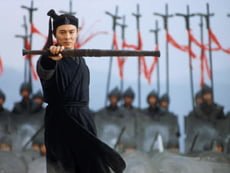Imagine gazing at Vincent van Gogh’s “Starry Night,” and the awe you would experience if the image suddenly swirled into the motion that it perpetually alludes to.
This is what you will experience if you see Yimou Zhang’s Hero. The film is visual poetry-a vibrant painting in motion.
Yet you will not be bored as you stare at the canvas, fading in and out of levels of understanding, for Hero is a fascinating story too. American viewers will most likely recognize crossover stars Jet Li (The One), Zhang Ziyi (Crouching Tiger, Hidden Dragon), and Donnie Yen (Shanghai Knights).
Nameless, played by Jet Li, arrives at the Kingdom of the Emperor Qin to tell how he defeated the three deadly assassins Broken Sword, Falling Snow, and Sky. Nameless moves closer to the Emperor as he accepts his rewards for defeating the three threats. All the while, Emperor Qin and Nameless unravel the full truth surrounding this great feat in a series of flashbacks.
The plot is intricate and inspired, but the grandeur of the film lies in the use of color and motion.
Yimou Zhang is known for his fixation on color, and the very titles of two of his earlier films, Raise the Red Lantern and Red Sorghum make this fact plain. Hero, however, goes much further.
In his previous films, Zhang focused on the color red to accentuate themes of passion and determination. In Hero, a full prism of color is developed that goes far beyond the red in previous movies. The vividness is exemplified in the confrontation between two warriors struck with grief.
Picture two women, clad in the red of a foreboding sunset, in an open wood. The trees, powerful and yet bent with sorrow, release a torrent of vibrant yellow petals, falling like tears of the sun. The fighting ensues; petals churn around flashing steel-the lethal instrument of one woman’s sorrow. Her foe falls, and the downpour of petals quivers into a cascade of molten red.
The battle between the assassin Falling Snow and her lover’s apprentice, Moon, is excellently choreographed and beautifully executed. What makes the scene truly striking, though, is the color and motion that is applied to it: swirling robes, flashing swords, falling pedals. This element is what makes the movie truly astonishing.
But color does not overshadow plot. The two are intimately joined. As Nameless and Emperor Qin continue to readdress Nameless’ tale, the entire color scheme shifts in harmony. The main colors shift from red to blue, and then white to green.
According to the Internet Movie Database (IMDB), these colors have thematic significance in the film. Red means imagination, blue is perceived reality, white signifies truth, and green manifests enlightenment and peace. These themes take on vast importance, and serve to deepen the plot while heightening the visual splendor.
“The color has no cultural or universal significance,” said Yimou Zhang in an interview with Liza Bear for indiewire.com. “I like Rashomon, and thought I could use different colors to represent different parts in the movie.”
The first realization of this significant color shift occurs when a scene, previously consisting of white walls and characters in red robes, is revisited. However, this time it is completely tinted in a deep and rich blue, carrying unmistakable significance, regardless of the viewer’s comprehension of it.
In the dramatic conclusion to our search for truth, truth itself is complicated. The desired ending cannot be, and the person who understands the Emperor most is the one who knows him the least. Only he, the enlightened one, was able to see the proper course and understand the sacrifices that must be made for it.
If you can appreciate the distinction between seeing a movie and experiencing a movie, if ever you looked at “Starry Night” and it came alive in your mind, you should see this film.

